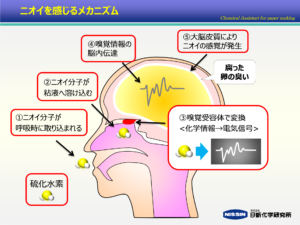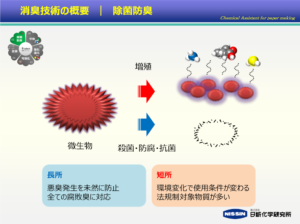Deodorizers for Wastewater
Deodorizers for Wasteewater Lineup
| Product name | Appearance | Recommended Conditions | Recommended Use Location | |||
|---|---|---|---|---|---|---|
| addition density(ppm) | mixture | sprinkling | spraying | |||
| BEAMSTAR WR | Strong hydrogen sulfide odor Decomposition smell in general |
100~500 | 〇 | 〇 | × | Kraft pulp production process
Drainage process Paper sludge |
| BEAMSTAR WT | Strong ammonia odor Decomposition smell in general |
100~500 | 〇 | 〇 | △ | |
| BEAMSTAR WPZ | Decomposition smell in general (odor-resistant) |
100~500 | 〇 | △ | × | |
| BEAMSTAR WSA | Strong hydrogen sulfide odor Decomposition smell in general |
100~500 | 〇 | 〇 | 〇 | |
What does 'smell' mean?
Smell substances are taken into the nose by breathing, and the olfactory receptors convert the smell substances into information through electrical signals.
This electrical information is transmitted to the cerebral cortex, which generates the sense of smell.
The problem is that, once converted into electrical signals in the brain, smell information becomes indistinguishable from memory information. Smells and past experiences are therefore very easily linked, and even the same smell can be perceived very differently by different people. Therefore, deodorisation methods must be selected with these factors in mind.

Stench and Decay
Bad odors are often produced by microbial decay, and passive anaerobic bacteria such as Escherichia coli perform normal respiration when there is sufficient oxygen, and when oxygen is scarce, anaerobic respiration occurs, using nutrient sources such as glucose as direct energy.
Anaerobic respiration breaks down glucose, producing organic acids and other substances that result in unpleasant odors.
Sulfate-reducing bacteria are also a type of biased anaerobic bacteria. Oxygen is toxic to biophilic anaerobes, and they multiply in conditions of low oxygen, during which sulfate-reducing bacteria convert sulfate ions into energy and produce hydrogen sulfide.
The process by which microorganisms engage in anaerobic respiration and activity is called fermentation or putrefaction. Putrefaction produces foul-smelling substances.

Deodorant Technology Overview: Deodorant Method
We have classified the main mechanisms used in our deodorant method into five categories: neutralization, redox, solubilization, masking pairling, and sterilization.
Since each of these methods has its own advantages and disadvantages, they work efficiently when used singly or in combination, taking into account the conditions of use.

Neutralization
Neutralization are used for odors that are highly water soluble and have a pH of acidic or alkaline. For example, ammonia can be neutralized with acidic substances to form ammonium salts, which can eliminate odors. pH is a reversible reaction, meaning that as the pH moves up and down, the deodorizing effect increases, but it also becomes more irritating, and when the pH returns to its original level, the odor is generated again.

Redox
Redox are used to change odors that are toxic or corrosive, such as hydrogen sulfide, into odorless substances. Unlike neutralization reactions, redox are irreversible. However, because of their high irritancy and the large number of regulated substances, they are not recommended for use in spraying, except for certain substances such as naturally extracted ingredients.

Solubilization
Solubilization is a method of dissolving difficult-to-dissolve odors, such as methyl mercaptan, in water using a solvent, surfactant, or other agent. Although it is a highly safe method of deodorization, it requires water and a solvent to dissolve the odor. Since the odorant is not altered, the odor will recur if the dissolved water is not treated.

Masking/Pairing
Masking/pairing eliminates odors by turning them into part of the aroma. Well known is that jasmine contains indole, a malodorous substance, in its aromatic composition, and it is possible to change indole into jasmine fragrance. This is a fast-acting method, but care must be taken because some people find the aromatic odor unpleasant because it can be unpleasant if not in balance with the odor.

Sterilization
Sterilization is a method of preventing the occurrence of bad odors by removing the causative bacteria. It is possible to prevent the occurrence of all putrid odors. However, microorganisms can become highly resistant to environmental changes, making them difficult to control, and microbicides are subject to many restrictions.

The product catalog of the deodorant “BEAMSTAR” series is available on the manufacturing technology database site “IPROS”. Click the icon below to download.

